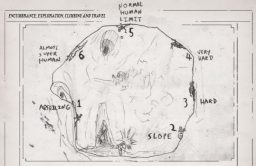Veins of the Earth and the Monster of Gravity
Thursday , 10, August 2017 Games, Tabletop Games, Uncategorized 7 Comments In an earlier column, I discussed a means to add tension to climbing and swimming in OSR type games by modeling gravity as a grappling monster using Douglas Cole’s Dungeon Grappling rules. I have refined that approach a bit and you can download the revised version here: Monster of Gravity.
In an earlier column, I discussed a means to add tension to climbing and swimming in OSR type games by modeling gravity as a grappling monster using Douglas Cole’s Dungeon Grappling rules. I have refined that approach a bit and you can download the revised version here: Monster of Gravity.
But, today I’d like to direct your attention to another alternative approach to adding detail and tension to climbing. Specifically, the approach presented in Veins of the Earth. But first, an introduction, Veins of the Earth is a supplement published under the Lamentations of the Flame Princess imprint; and, written by Patrick Stuart with Illustrations by Scrap Princess. And, a wonderful bit of work it is.
Before I get to the meat of it, I need to digress a bit. Like a lot of aging role players I had a pile of fun playing the old Descent into the Depths of the Earth module(s) which was preceded by the Giants series and followed by the Vault of the Drow, with the finale being Queen of the Demonweb Pits. Except in my case, and I expect many others, our party never made it to the Vault much less the Demonweb. Our party descended into the depths and never returned. It was a total party kill. The many miles of tunnel were a logistic nightmare. As we proceeded we slowly used up our equipment. Like a rocket trying to reach orbit by throwing torches, oil, and iron spikes behind us, our loads got lighter and lighter and soon we were at a point of no return. We could not go back as we would run out of supplies before we reached the light. Eventually, we used up our last oil fighting some trolls. We won the fight but, then the DM noted the pools of burning oil were burning out. A quick check of our equipment lists showed no oil and no torches. We were out of light. And, then the oozes came. Our panicked retreat the being picked off one by one in the dark was one of the more memorable gaming experiences I’ve had.
Veins of the Earth takes the premise of Descent into the Depths of the Earth and make it generic. Why the characters go there isn’t much addressed but, they are there, it’s endless, and the characters will be there for a long time. And from there presents a whole bundle of mechanisms to manage such an expedition. There are rules of managing light (light becomes the main currency of the underdark), generating caves and routes, food (and starvation), monsters (and cultures); and climbing. Taken together it is a overwhelming but, in practice not complex in any one step. Without being a full review of the thing, the book is wonderful. The game mechanisms presented are well thought out and work together in a variety of obvious and not-so-obvious-ways. The text is a joy to read in itself. The book could have been half the length with a less poetic and utilitarian prose. But, the poetry is necessary to get the tone of what such travels consist of. And, if prosaic prose is what you desire Wizards of the Coast can provide you with that by the bucketful. And, the loose, organic, and obscure artwork by Scrap Princess perfectly matches the book. The construction of the thing is quite nice too. Even at well over three hundred pages its sewn binding will open flat without any obvious damage to the spine. Plus, it comes equipped with two ribbon bookmarks because a DM will need more than one. So it’s recommended.

Back to climbing. Veins of the Earth, presents a short chapter on climbing. And, in that chapter, presents an entirely different approach to climbing than the one I took with the Monster of Gravity. Yet, it accomplishes a lot of the same things and a few things more. The process goes like this: the amount of time spent studying the route sets the number needed to be rolled to successfully climb, the difficulty of the route (abseil, slope, hard, very hard, human limit, and superhuman) determines the severity of the consequences of failing, then if failure occurs, falling damage is taken. The mechanism of consequences I’d like to look at more closely here. Each difficulty type has its own table consisting of a list of ability stats each with its own consequence of failure. A player rolls a single d20 and checks the first stat (constitution). A successful roll under constitution means you move onto the the next stat using the same roll and the first failure is taken. Failure of the constitution roll means that the same follow-up ability checks occur but, are cumulative rather than just taking the first failure. A player who rolls poorly can thus experience a figurative cascade of consequences resulting from a failed climb roll. Let me say, I really like this approach and, in particular, how it brings every ability statistic into relevance. I plan to use it in conjunction with my own Monster of Gravity approach. In fact, I expect I may end up with a hybrid system where the monster of gravity approach is only used at key critical points when more detail may add to a game. So, that is just a few pages of Veins of the Earth that may alter how I play. There are several hundred more in the book.

“Who wants to worry about logistics?” asks the player who doesn’t understand that every aspect of play is logistics. Hit points are logistics, for God’s sake.
First level thinkers always complain that the first level “light” spell seems useless compared to the obviously more utilitarian “sleep” or “magic missile”. Until the DM has his clever kobolds live beyond a water cascade sure to douse any open flames and perhaps even lanterns. Or until the oil runs out. Then you’ll be glad to have that reliable source of light at your disposal. It wouldn’t get you to the surface from the Vault of the Drow, but it might buy you enough time to think of something else.
I will never forget the forboding sense of unease I felt during my first ever gaming session with D&D3.0. At the entrance to the first dungeon, one player whips out a sunstick and attaches it to the top of his helmet like a fantasy version of the German Kaiser helmet, and voila! – one of the key challenges to any dungeon was negated at first level with very little cash required.
Yes, exactly. Magic has often been used to negate environmental challenges. And, some key decisions as to spell level for certain spells can create havoc with the sense of tension. Create water for example. This video discusses how a small change can have big effects on game play.
https://www.youtube.com/watch?v=5cfHZQWBfvg
But, year, logistics are important and players who complain about logistics are people who don’t really want to play the game. Though, there should be a caveat that a game should make some effect to make tracking the logistics simple to do which for D&D has often been glossed over.
Veins of the Earth has some novel ways of making light and food both truly economic items and also points of tension. And it simplifies the logistics of food at the same time.
Read the ebook. Really good stuff.
-
Yeah. I focused on climbing because it was on my mind lately. But, the light and food issues are nicely done as well.
Torchbearer does an interesting thing. Your character gets hungry, exhausted, sick, angry or injured. If you’re all of those, you’re also dead. I don’t think it even has hit points; battle, or the environment, or failure, all add up together to you just freaking dying.
-
I haven’t gone the full monty yet, but I’ve always thought this would be a nice mechanic (conditions rather than points) that would nicely sidestep “death of 1000 cat scratches” or whatever resolution issues one has. Having a combination of conditions equate to a mortal condition is a nice touch, too.
-
Yeah, the game was basically their attempt to make a game that is ABOUT being a low level adventurer in Moldvay DnD.
One of the cute things about it is how Halflings being party animals who know how to cook can save everyone’s life. The fact that you can save your party from a potential TPK with a good meal and some tipsy singing is a great tribute to Tolkien, IMO 🙂
-